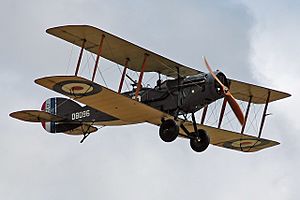John Everard Gurdon facts for kids
Quick facts for kids
John Everard Gurdon
DFC
|
|
|---|---|
| Born | 24 May 1898 Balham, Surrey, England |
| Died | 14 April 1973 (aged 74) Alassio, Italy |
| Allegiance | United Kingdom |
| Service/ |
British Army Royal Air Force |
| Years of service | 1917–1918 1940–1941 |
| Rank | Pilot Officer |
| Service number | 86019 |
| Unit | Suffolk Regiment No. 22 Squadron |
| Battles/wars | First World War Second World War |
| Awards | Distinguished Flying Cross |
| Other work | Journalist and author |
John Everard Gurdon was a brave British pilot during the First World War. He was known as a "flying ace" because he shot down 28 enemy aircraft! He was born on May 24, 1898, and passed away on April 14, 1973. He was awarded the Distinguished Flying Cross for his amazing courage.
Contents
Early Life and Joining the Army
John Gurdon was born in Balham, Surrey, England. His parents were John Gurdon and Mary Gray Rattray. He went to Tonbridge School in Kent.
In September 1916, John went to the Royal Military College, Sandhurst. This was a special school to train army officers. After he finished his training, he became a second lieutenant in the Suffolk Regiment on May 1, 1917.
Flying in the First World War
In May 1917, John Gurdon joined the Royal Flying Corps, which was the air force at the time. He became a pilot and finished his training. In 1918, he joined No. 22 Squadron. He flew a type of plane called the Bristol F.2 Fighter.
John Gurdon achieved all 28 of his victories between April 2 and August 13, 1918. He shot down enemy planes while flying the Bristol Fighter. Seventeen of his victories were using the front gun of his plane.
The "Two versus Twenty" Battle
On May 7, John Gurdon was part of a famous air battle called the "Two versus Twenty". He and his observer, 2nd Lt. John Thornton, were flying one Bristol Fighter. Another Bristol Fighter was flown by Alfred Atkey with his observer Charles George Gass.
These two British planes faced a group of twenty enemy aircraft! Gurdon and Thornton shot down three enemy planes. Atkey and Gass shot down five. It was an incredible fight against many more enemy aircraft.
Receiving the Distinguished Flying Cross
Because of his bravery in battles like "Two versus Twenty", John Gurdon received the Distinguished Flying Cross. This award was officially announced on August 2.
His award statement said he was a "brilliant fighting pilot." It also said he was very determined and didn't care about his own danger. It mentioned that he had personally destroyed nine enemy machines. During one patrol, he attacked seven enemy planes. Even when more enemy planes joined, making twenty in total, he kept fighting. He shot down one of the enemy planes himself.
Injuries and Leaving Service
On July 10, John Gurdon's plane was badly hit. He was shot in his left arm, and his gunner, Lt. J. J. Scaramaga, was killed.
On July 23, he was promoted to temporary captain and became a flight commander. This meant he led a group of planes. However, in August, he got a concussion from an anti-aircraft shell that exploded too close. He was sent back to the UK in September. Because of his injuries, he left the army on December 21, but he was allowed to keep the rank of captain.
He was officially credited with destroying 13 enemy aircraft and sharing in the destruction of one more. He also forced 14 enemy planes to go "out of control."
Life Between the Wars
After the First World War, John Gurdon became a journalist and a writer. He published his first novel, Over and Above, in 1919. He also translated a German book about their air force, which was published in English in 1921.
He wrote another novel, Feeding The Wind, in 1924. However, in December 1925, he had money problems and was declared bankrupt. To pay off his debts, he wrote many more novels and short stories. Most of these were adventure stories for young adults. They appeared in magazines like The Modern Boy and Air Stories. He finally sorted out his money problems in late 1937. He continued to publish books until the Second World War began.
Serving in the Second World War
Even though he had lost sight in one eye from a car crash in 1935 and had a hip problem from an old flying accident, John Gurdon wanted to help. He joined the Royal Air Force Volunteer Reserve on September 20, 1940. He became a pilot officer.
He worked as an instructor, teaching other pilots. He even managed to fly on some bombing missions unofficially as a front gunner on Wellington planes. But after another landing accident made his hip problem worse, he had to leave the air force on September 29, 1941.
Later Life and Family
John Gurdon published two more novels in the early 1950s. He passed away on April 14, 1973, in Alassio, Italy.
He married Florence M. Pleming in 1920. They had three sons: John (known as Robin), Philip, and David. Sadly, his eldest son, Sergeant John Robert Gurdon, was killed in action in April 1943 while flying Wellingtons for No. 166 Squadron. His son Philip Gurdon also served, flying Spitfires for No. 273 Squadron in Burma.


